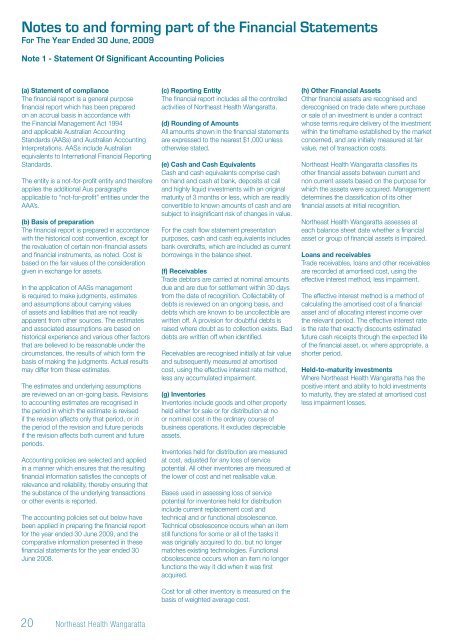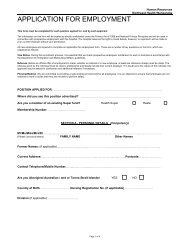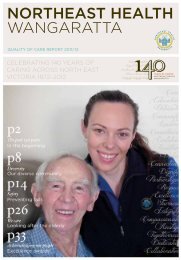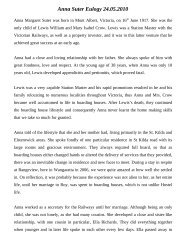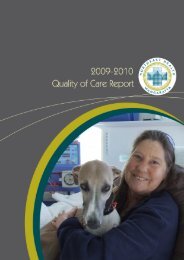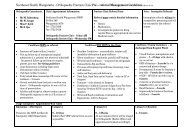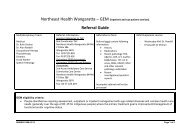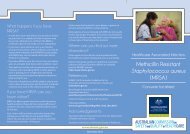2008-2009 Financial and Performance Report - Northeast Health ...
2008-2009 Financial and Performance Report - Northeast Health ...
2008-2009 Financial and Performance Report - Northeast Health ...
Create successful ePaper yourself
Turn your PDF publications into a flip-book with our unique Google optimized e-Paper software.
Notes to <strong>and</strong> forming part of the <strong>Financial</strong> Statements<br />
For The Year Ended 30 June, <strong>2009</strong><br />
Note 1 - Statement Of Significant Accounting Policies<br />
(a) Statement of compliance<br />
The financial report is a general purpose<br />
financial report which has been prepared<br />
on an accrual basis in accordance with<br />
the <strong>Financial</strong> Management Act 1994<br />
<strong>and</strong> applicable Australian Accounting<br />
St<strong>and</strong>ards (AASs) <strong>and</strong> Australian Accounting<br />
Interpretations. AASs include Australian<br />
equivalents to International <strong>Financial</strong> <strong>Report</strong>ing<br />
St<strong>and</strong>ards.<br />
The entity is a not-for-profit entity <strong>and</strong> therefore<br />
applies the additional Aus paragraphs<br />
applicable to “not-for-profit” entities under the<br />
AAA’s.<br />
(b) Basis of preparation<br />
The financial report is prepared in accordance<br />
with the historical cost convention, except for<br />
the revaluation of certain non-financial assets<br />
<strong>and</strong> financial instruments, as noted. Cost is<br />
based on the fair values of the consideration<br />
given in exchange for assets.<br />
In the application of AASs management<br />
is required to make judgments, estimates<br />
<strong>and</strong> assumptions about carrying values<br />
of assets <strong>and</strong> liabilities that are not readily<br />
apparent from other sources. The estimates<br />
<strong>and</strong> associated assumptions are based on<br />
historical experience <strong>and</strong> various other factors<br />
that are believed to be reasonable under the<br />
circumstances, the results of which form the<br />
basis of making the judgments. Actual results<br />
may differ from these estimates.<br />
The estimates <strong>and</strong> underlying assumptions<br />
are reviewed on an on-going basis. Revisions<br />
to accounting estimates are recognised in<br />
the period in which the estimate is revised<br />
if the revision affects only that period, or in<br />
the period of the revision <strong>and</strong> future periods<br />
if the revision affects both current <strong>and</strong> future<br />
periods.<br />
Accounting policies are selected <strong>and</strong> applied<br />
in a manner which ensures that the resulting<br />
financial information satisfies the concepts of<br />
relevance <strong>and</strong> reliability, thereby ensuring that<br />
the substance of the underlying transactions<br />
or other events is reported.<br />
The accounting policies set out below have<br />
been applied in preparing the financial report<br />
for the year ended 30 June <strong>2009</strong>, <strong>and</strong> the<br />
comparative information presented in these<br />
financial statements for the year ended 30<br />
June <strong>2008</strong>.<br />
(c) <strong>Report</strong>ing Entity<br />
The financial report includes all the controlled<br />
activities of <strong>Northeast</strong> <strong>Health</strong> Wangaratta.<br />
(d) Rounding of Amounts<br />
All amounts shown in the financial statements<br />
are expressed to the nearest $1,000 unless<br />
otherwise stated.<br />
(e) Cash <strong>and</strong> Cash Equivalents<br />
Cash <strong>and</strong> cash equivalents comprise cash<br />
on h<strong>and</strong> <strong>and</strong> cash at bank, deposits at call<br />
<strong>and</strong> highly liquid investments with an original<br />
maturity of 3 months or less, which are readily<br />
convertible to known amounts of cash <strong>and</strong> are<br />
subject to insignificant risk of changes in value.<br />
For the cash flow statement presentation<br />
purposes, cash <strong>and</strong> cash equivalents includes<br />
bank overdrafts, which are included as current<br />
borrowings in the balance sheet.<br />
(f) Receivables<br />
Trade debtors are carried at nominal amounts<br />
due <strong>and</strong> are due for settlement within 30 days<br />
from the date of recognition. Collectability of<br />
debts is reviewed on an ongoing basis, <strong>and</strong><br />
debts which are known to be uncollectible are<br />
written off. A provision for doubtful debts is<br />
raised where doubt as to collection exists. Bad<br />
debts are written off when identified.<br />
Receivables are recognised initially at fair value<br />
<strong>and</strong> subsequently measured at amortised<br />
cost, using the effective interest rate method,<br />
less any accumulated impairment.<br />
(g) Inventories<br />
Inventories include goods <strong>and</strong> other property<br />
held either for sale or for distribution at no<br />
or nominal cost in the ordinary course of<br />
business operations. It excludes depreciable<br />
assets.<br />
Inventories held for distribution are measured<br />
at cost, adjusted for any loss of service<br />
potential. All other inventories are measured at<br />
the lower of cost <strong>and</strong> net realisable value.<br />
Bases used in assessing loss of service<br />
potential for inventories held for distribution<br />
include current replacement cost <strong>and</strong><br />
technical <strong>and</strong> or functional obsolescence.<br />
Technical obsolescence occurs when an item<br />
still functions for some or all of the tasks it<br />
was originally acquired to do, but no longer<br />
matches existing technologies. Functional<br />
obsolescence occurs when an item no longer<br />
functions the way it did when it was first<br />
acquired.<br />
Cost for all other inventory is measured on the<br />
basis of weighted average cost.<br />
(h) Other <strong>Financial</strong> Assets<br />
Other financial assets are recognised <strong>and</strong><br />
derecognised on trade date where purchase<br />
or sale of an investment is under a contract<br />
whose terms require delivery of the investment<br />
within the timeframe established by the market<br />
concerned, <strong>and</strong> are initially measured at fair<br />
value, net of transaction costs.<br />
<strong>Northeast</strong> <strong>Health</strong> Wangaratta classifies its<br />
other financial assets between current <strong>and</strong><br />
non current assets based on the purpose for<br />
which the assets were acquired. Management<br />
determines the classification of its other<br />
financial assets at initial recognition.<br />
<strong>Northeast</strong> <strong>Health</strong> Wangaratta assesses at<br />
each balance sheet date whether a financial<br />
asset or group of financial assets is impaired.<br />
Loans <strong>and</strong> receivables<br />
Trade receivables, loans <strong>and</strong> other receivables<br />
are recorded at amortised cost, using the<br />
effective interest method, less impairment.<br />
The effective interest method is a method of<br />
calculating the amortised cost of a financial<br />
asset <strong>and</strong> of allocating interest income over<br />
the relevant period. The effective interest rate<br />
is the rate that exactly discounts estimated<br />
future cash receipts through the expected life<br />
of the financial asset, or, where appropriate, a<br />
shorter period.<br />
Held-to-maturity investments<br />
Where <strong>Northeast</strong> <strong>Health</strong> Wangaratta has the<br />
positive intent <strong>and</strong> ability to hold investments<br />
to maturity, they are stated at amortised cost<br />
less impairment losses.<br />
20 <strong>Northeast</strong> <strong>Health</strong> Wangaratta


